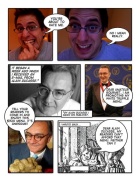Rôti de Porc au Chou Rouge Epicé, Pommes et Pruneaux
1 tablespoon olive oil
One 800-gram (1 3/4 pounds) boneless center cut pork roast (in French, rôti de porc dans le filet)
Fine sea salt
1 small head red cabbage, quartered, cored, and sliced thinly
2 medium baking apples, peeled, cored, and cut in eighths
8 prunes, pitted and halved
4 whole garlic cloves (with their papery skin still on)
Whole coriander seeds
French four-spice mix (ground nutmeg, ginger, cinnamon, and cloves)
1/2 cup red wine (I used what was left of an excellent Fiefs Vendéens Gamay, “Gammes d’Eté” 2004 by Domaine Saint-Nicolas)
Freshly ground pepper
Serves 4.
Heat the olive oil in a large cast-iron pot or Dutch oven over medium-high heat. Add the roast and sear for a few minutes, flipping the meat regularly, until browned all over. Season with salt and set aside.Lower the heat to medium. Add the cabbage, apples, prunes, and garlic to the pot, stir to coat, and cook for 5 minutes, stirring regularly, until the cabbage starts to soften. Season with whole coriander seeds, French four-spice (light-handedly), and salt. Stir to combine.Form a little nest in the middle of the vegetables and place the roast there. Pour the wine over the meat and vegetables, cover, lower the heat to medium-low, and simmer for about an hour, stirring from time to time to make sure the vegetables don’t burn at the bottom, until the meat is cooked through (I just cut a slice to check when I think it’s done, but if you have a meat thermometer, it should read 70°C / 160°F).Remove the lid, turn the heat up to medium-high and cook for a few minutes, stirring frequently, until the juices have reduced by half. Taste the vegetables, adjust the seasoning, sprinkle with pepper, and serve with strong mustard on the side.
From: Chocolate & Zucchini






